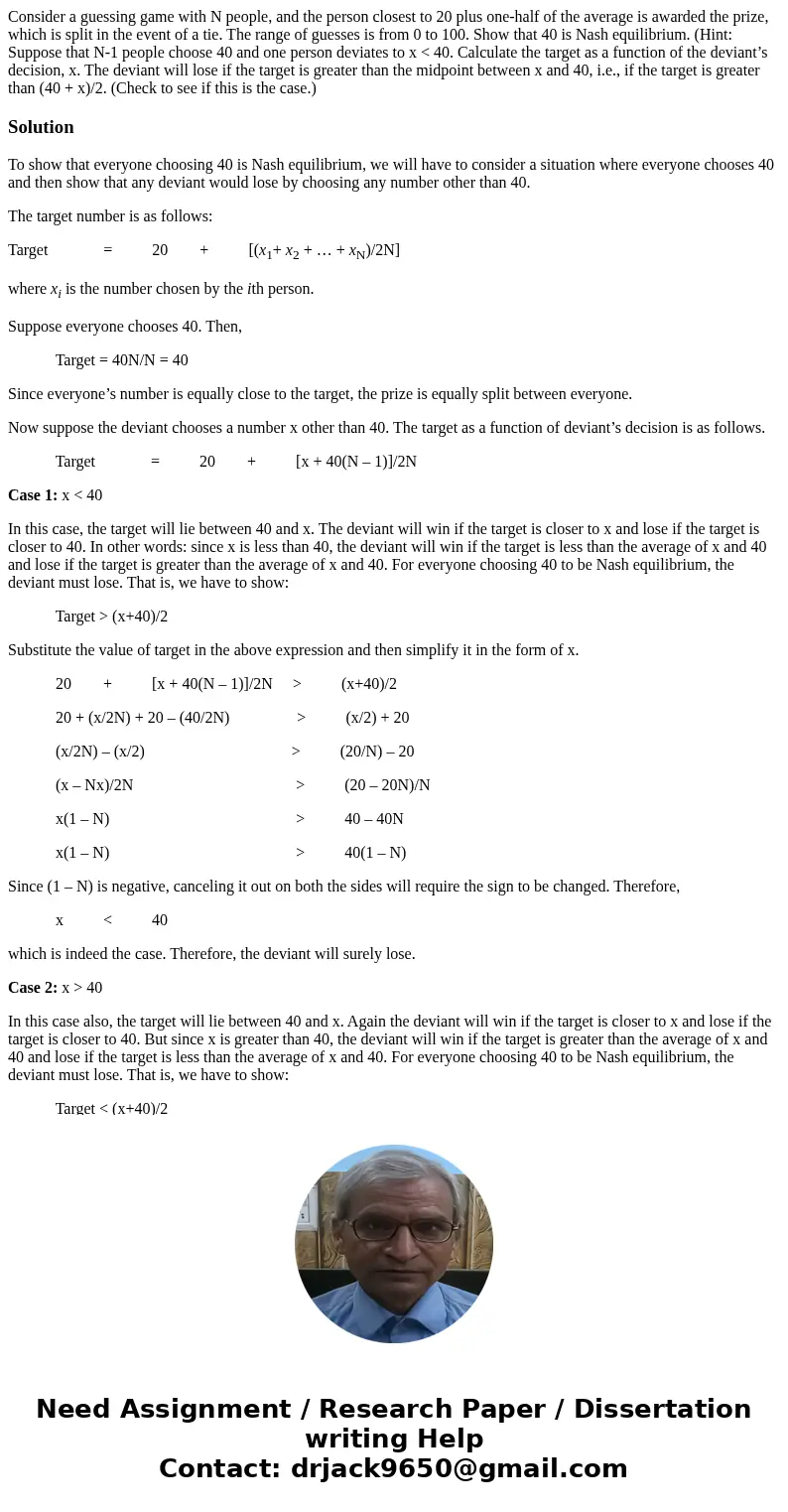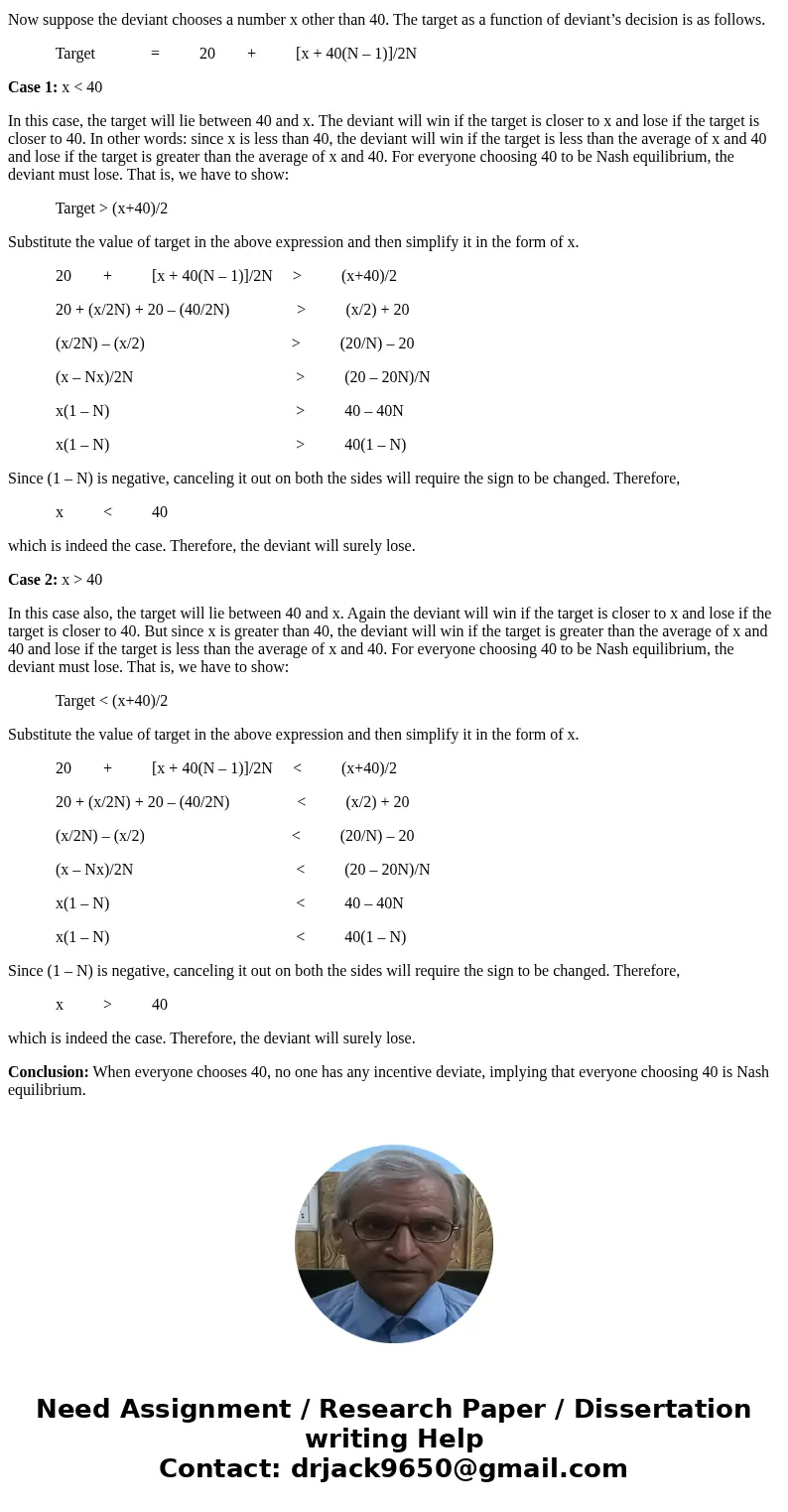Consider a guessing game with N people and the person closes
Consider a guessing game with N people, and the person closest to 20 plus one-half of the average is awarded the prize, which is split in the event of a tie. The range of guesses is from 0 to 100. Show that 40 is Nash equilibrium. (Hint: Suppose that N-1 people choose 40 and one person deviates to x < 40. Calculate the target as a function of the deviant’s decision, x. The deviant will lose if the target is greater than the midpoint between x and 40, i.e., if the target is greater than (40 + x)/2. (Check to see if this is the case.)
Solution
To show that everyone choosing 40 is Nash equilibrium, we will have to consider a situation where everyone chooses 40 and then show that any deviant would lose by choosing any number other than 40.
The target number is as follows:
Target = 20 + [(x1+ x2 + … + xN)/2N]
where xi is the number chosen by the ith person.
Suppose everyone chooses 40. Then,
Target = 40N/N = 40
Since everyone’s number is equally close to the target, the prize is equally split between everyone.
Now suppose the deviant chooses a number x other than 40. The target as a function of deviant’s decision is as follows.
Target = 20 + [x + 40(N – 1)]/2N
Case 1: x < 40
In this case, the target will lie between 40 and x. The deviant will win if the target is closer to x and lose if the target is closer to 40. In other words: since x is less than 40, the deviant will win if the target is less than the average of x and 40 and lose if the target is greater than the average of x and 40. For everyone choosing 40 to be Nash equilibrium, the deviant must lose. That is, we have to show:
Target > (x+40)/2
Substitute the value of target in the above expression and then simplify it in the form of x.
20 + [x + 40(N – 1)]/2N > (x+40)/2
20 + (x/2N) + 20 – (40/2N) > (x/2) + 20
(x/2N) – (x/2) > (20/N) – 20
(x – Nx)/2N > (20 – 20N)/N
x(1 – N) > 40 – 40N
x(1 – N) > 40(1 – N)
Since (1 – N) is negative, canceling it out on both the sides will require the sign to be changed. Therefore,
x < 40
which is indeed the case. Therefore, the deviant will surely lose.
Case 2: x > 40
In this case also, the target will lie between 40 and x. Again the deviant will win if the target is closer to x and lose if the target is closer to 40. But since x is greater than 40, the deviant will win if the target is greater than the average of x and 40 and lose if the target is less than the average of x and 40. For everyone choosing 40 to be Nash equilibrium, the deviant must lose. That is, we have to show:
Target < (x+40)/2
Substitute the value of target in the above expression and then simplify it in the form of x.
20 + [x + 40(N – 1)]/2N < (x+40)/2
20 + (x/2N) + 20 – (40/2N) < (x/2) + 20
(x/2N) – (x/2) < (20/N) – 20
(x – Nx)/2N < (20 – 20N)/N
x(1 – N) < 40 – 40N
x(1 – N) < 40(1 – N)
Since (1 – N) is negative, canceling it out on both the sides will require the sign to be changed. Therefore,
x > 40
which is indeed the case. Therefore, the deviant will surely lose.
Conclusion: When everyone chooses 40, no one has any incentive deviate, implying that everyone choosing 40 is Nash equilibrium.


 Homework Sourse
Homework Sourse